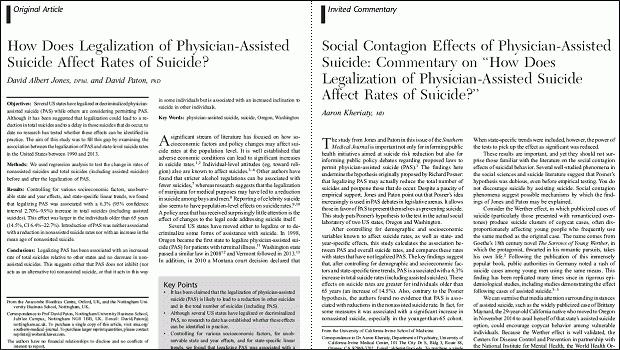Jones Paton and Kheriaty "suicide contagion" playbook exposed

In 2015, Dr David Jones and Prof. David Paton published an article titled “How does legalization of physician-assisted suicide affect rates of suicide?” in the Southern Medical Journal. The article purported to establish suicide contagion from Oregon and Washington Death With Dignity Act (DWDA) deaths to “total suicides.” It also purported to establish no decrease in general suicide rates, which Jones & Paton argued should occur by substitution of assisted death for some general suicides. (Notice how these two ‘expected’ results — an anticipated rise and an anticipated fall in suicide rates — are at odds in principle.)
In my thorough and empirically-backed response, I expose the disgraceful playbook of these authors as they shambolically commit no fewer than ten deadly sins against science in the pursuit of their opposition to lawful assisted dying.
Executive Summary
In 2015, Dr David Jones & Prof. David Paton published an article in the Southern Medical Journal titled “How does legalization of physician-assisted suicide affect rates of suicide?” This study examines the article, as well as an enthusiastic editorial of it by Dr Aaron Kheriaty in the same journal issue, both of which portray “suicide contagion” from Oregon and Washington’s death with dignity acts (DWDA).
However, while contagion from general suicides is a well-established phenomenon, there are multiple sound reasons to reject contagion theory in relation to assisted deaths, including:
- Most healthcare professionals readily acknowledge key differences in the characteristics of assisted deaths: for example, a fully informed, tested and rational decision with shared decision-making.
- Those using Oregon and Washington’s DWDAs are, by qualifying for it, already actively dying. Thus, they are choosing between two ways of dying rather than between living and dying.
- Most of those using the DWDA discuss it with their families (expected, peaceful death), whereas most general suicides occur in isolation and without discussion (unexpected, often violent death).
- Multiple studies show that while families of general suicide experience complicated bereavement, families of assisted dying cope at least as well as, and in some cases better than, the general population or those who considered but did not pursue assisted death.
Even if “suicide contagion from assisted dying” theory were sound, direct evidence from official government sources shows that the number of potential suicides in Oregon in 2014 would have been fewer than 2 in 855 cases: undetectable by general modelling methods.
Jones & Paton’s article title conveys an air of skilled and scientific neutrality. However, close examination of the article, and Kheriaty’s editorialisation of it, reveals least ten serious flaws or ‘scientific sins.’
The authors demonstrated little understanding of the complex issues surrounding suicide, willingness to unjustifiably equate assisted dying with general suicide, contentment with failing to search for, consider or include contrary evidence including from sources they cite to argue their case, unreasonable trust in a model that couldn’t hope to legitimately resolve their premises, satisfaction with executing their model amateurishly, a disposition to overstate confidence of causation in the absence of meaningful statistical correlations, and an inclination for emphasising results in accordance with their theories while de-emphasising or ignoring others.
Any of these flaws was serious enough to invalidate Jones & Paton’s article and Kheriaty’s conclusions of it, yet there is not one deadly flaw: there are at least ten.
Their claim of a supposed 6.3% suicide contagion rate from assisted dying in Oregon and Washington is a conceptual and mathematical farce.
The Southern Medical Journal is a peer-reviewed journal. However, it is difficult to reconcile the rigorous standards and sound reputation that peer review is intended to maintain, with the numerous, egregious flaws in this study and its dissemination.
Rather than inform the ongoing conversation about lawful assisted dying, the Jones & Paton and Kheriaty articles misinform and inflame it.
Given the numerous egregious flaws, both articles ought to be retracted.

